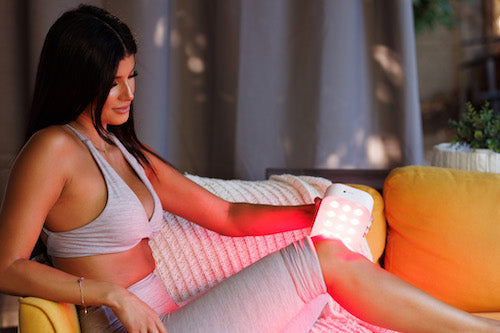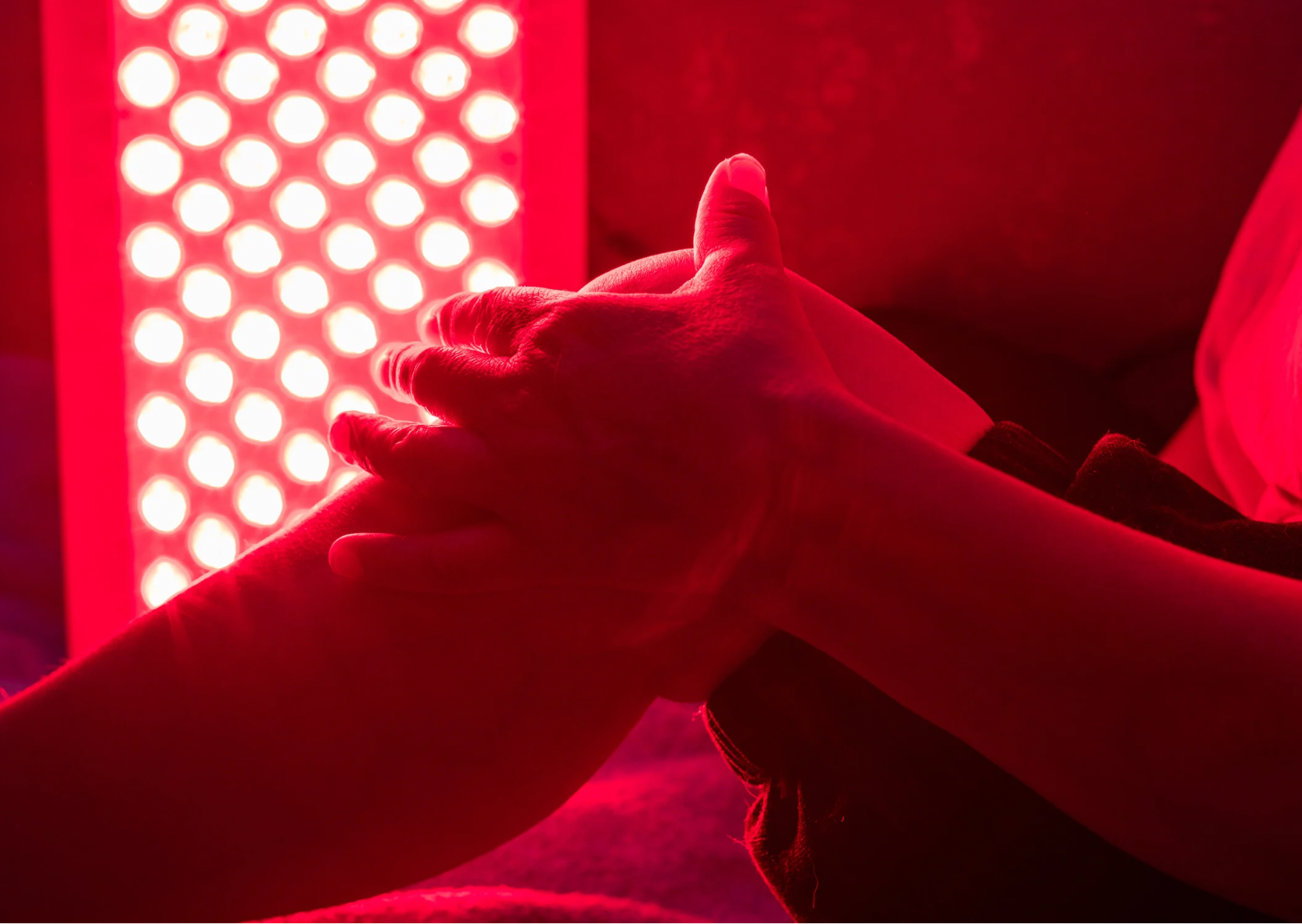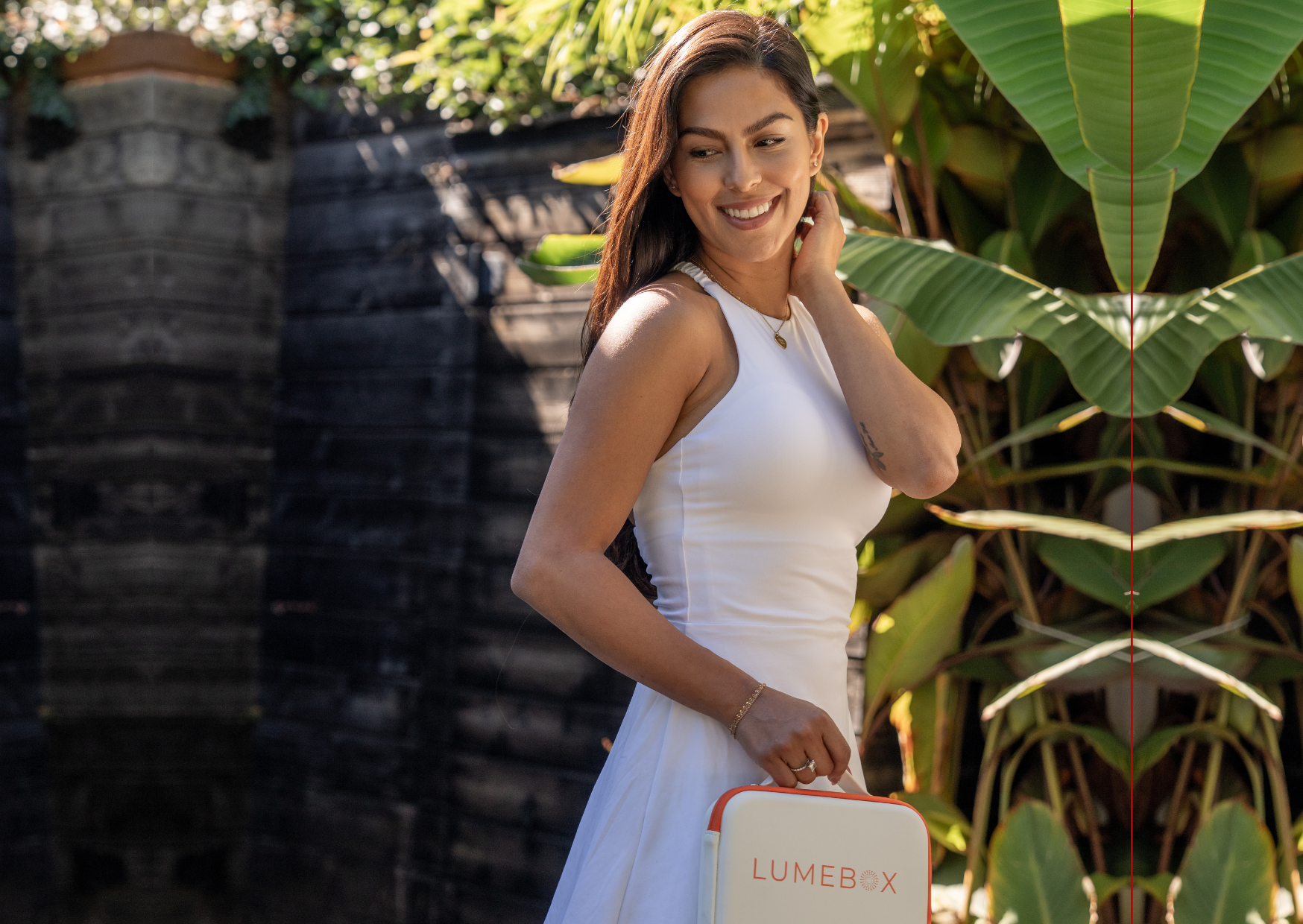Beginner's Guide to Red Light Therapy
If you're on social media, are an avid reader of health and wellness blogs, or a frequenter of wellness treatment centers, chances are you've crossed paths with Red Light Therapy (RLT) by now. You may have seen it in the form of portable handheld devices, healing pads, wrap belts, full-body beds, desk lamps, or face masks. The truth is, RLT is making its way into the mainstream, becoming a staple in both clinical settings and at-home wellness routines around the world.
But what exactly is RLT, and why is it soaring in popularity? Is it another fleeting wellness fad, or does it hold genuine promise? These are all valid questions, and we're here to dive deep and unveil the mysteries of RLT.
Unpacking RLT: Shedding Light on Its Mechanism
For centuries, medical practitioners have harnessed the power of light for healing. However, traditional sunlight therapies often came with a major downside: harmful UV radiation capable of damaging our skin. Red Light Therapy (RLT) takes the best part of light therapy—the healing aspects—while ditching the UV baggage.

But to grasp how RLT works, we need to start with the basics. Our body's cells are little powerhouses that require energy to carry out their various functions. Whether it's our muscle cells contracting, hair cells growing, or skin cells repairing and producing collagen, they all need energy to thrive. This energy is generated by our cellular factories, known as mitochondria, which convert the food we eat into a usable form of energy called ATP.
RLT targets these mitochondria. More specifically, it taps into our cellular batteries and recharges them, just like how we plug in our phones to recharge their batteries. This revitalizes our cells, allowing them to function at their peak.
Why Red Light? The Penetrating Power of Red and Near Infrared Light
Now, you might wonder why red light, of all the colors in the spectrum? Why not blue or green? The answer lies in penetration. Red and near-infrared light possess the unique ability to penetrate the skin more effectively than their counterparts.
This penetration may reach target tissues where our mitochondria reside. When activated by red and near-infrared light, these mitochondria ramp up their energy production, resulting in increased ATP levels.
In short, RLT helps recharge cells, supporting their natural function and overall well-being.
What Does the Science Say?
But you might think, "Sure, this all sounds great, but where's the science?" Over 2,000 studies have explored RLT's benefits, with numerous findings that demonstrate its prowess.
Skin Rejuvenation: RLT has shown a remarkable capacity to help rejuvenate the skin. Studies suggest RLT may reduce the appearance of wrinkles and support healthy collagen.
A study of 136 volunteers showed significant improvement in overall skin complexion, skin feeling, profilometrically assessed skin roughness, and increased collagen density measured using ultrasonography [9].
In another randomized, double-blind, placebo-controlled study on 76 patients treated with LED devices saw a reduction in the appearance of wrinkles, improved skin elasticity, and also biochemical markers of increased fibroblast activity [10]. As fibroblasts are involved in collagen production, an increase in fibroblasts activity could contribute to higher collagen production, leading to more supple and youthful skin.
There also is growing evidence that RLT is capable of modulating key cellular characteristics associated with skin fibrosis (aka skin scarring) [11].
Finally, a systematic review and meta-analysis suggests that PBM therapy may support skin renewal and reduce the incidence of radiation dermatitis in patients undergoing radiotherapy treatment [12].
Joints and Inflammation: For those dealing with joint discomfort, RLT may offer temporary relief.
A meta-analysis concluded that low-level laser therapy (LLLT), a form of RLT, reduces pain in adults with musculoskeletal disorders [13].
LLLT was also found to significantly relieve heel pain in patients with plantar fasciitis (tendinitis of the foot), with the efficacy of treatment lasting for 3 months thereafter [14].
Similar results demonstrating temporary pain relief was found in a systematic review of patients with temporomandibular disorder (pain and dysfunction of the jaw joints and muscles) [15].
Healing and Recovery: RLT isn't just about appearance; it could also support natural healing processes in the body, like tissue repair.
For instance, a systematic review reported that LLLT when used in skin burns was associated with improved microcirculation and cellular proliferation, thereby contributing to an accelerated healing process [16].
Additionally, Laser and LED-based PBM have also been utilized in dentistry as part of orthodontic treatment to reduce pain after orthodontic appliance placement, and stimulation in oral medicine [17].
Muscle Functions: Muscles, being densely rich in mitochondria, seem to be particularly receptive to RLT.
Preclinical animal experiments and human clinical studies of LLLT on muscle fatigue and injury suggest the possible use of PBM for preconditioning to improve performance, as well as post-workouts to reduce muscle fatigue, soreness, and injuries [18].
Pre-exercise PBM (laser) therapy applied on twenty-two high-level male soccer players in a randomized, triple-blind, placebo-controlled crossover trial found an important antioxidant effect, decreased exercise-induced oxidative stress, performance improvements, and post-exercise recovery [19].
Lastly, a review of randomized controlled trials and case-control studies found that PBM led to a gain in muscle mass after training while also reducing inflammation and oxidative stress in muscle tissue biopsies. These benefits were observed in both trained and untrained individuals, as well as elite athletes [20].
And these are just some of the well-researched benefits. Ongoing studies explore RLT's potential in various domains, from brain conditions [21] and mood to the appearance of cellulite, gut health [22], and more. Excitingly, new applications keep emerging, expanding the boundaries of RLT's healing potential.
Individualized Light Therapy
As we delve deeper into RLT research, one thing becomes evident: every individual responds to light differently. Just like with nutrition, where no one diet suits all, the optimal RLT "protocol" varies among individuals and devices. This diversity makes it challenging to establish standardized protocols and measurements. Yet, at-home LED-based RLT remains generally safe, making it an exciting modality to discuss with your healthcare provider, provided you have no medical contraindications.
The Light of Tomorrow: Harnessing the Benefits of Light Exposure
Light energy is an essential yet underutilized tool in the realm of health and wellness. With the continuous advancement of RLT, we've discovered a potential means to unlock the benefits of light exposure without harmful side effects.
If, like 90% of Americans, you spend the majority of your time indoors and seek efficient ways to incorporate light's benefits into your life, RLT may be an option worth exploring with your healthcare provider. However, not all RLT devices are created equal. The lack of regulatory standards and poor quality control in the market makes it essential to discern and choose reliable devices carefully.
Download our free guide with pointers on how to select a trustworthy RLT device.
In a world where the healing potential of light is becoming increasingly evident, RLT stands as a beacon of hope. It's a tool that holds the promise of numerous benefits, a way to optimize our health and well-being while basking in the light.
Already have a LUMEBOX? Download our 6 time-saving tricks guide!
Medical Disclaimer: The information contained in this blog post is intended for educational purposes only and should not be used as medical advice. Everyone responds to light differently. Testimonials are not a guarantee of the results you or anyone who uses LUMEBOX will get because your success depends entirely on your circumstances, and the studies on red light therapy shared were not specifically performed using LUMEBOX. Please check with your doctor before using red light therapy and do not change your medical treatments or lifestyle without consulting your physician first.
References:
- Avci P, Gupta A, Sadasivam M, Vecchio D, Pam Z, Pam N, Hamblin MR. Low-level laser (light) therapy (LLLT) in skin: stimulating, healing, restoring. Semin Cutan Med Surg. 2013 Mar;32(1):41-52. PMID: 24049929; PMCID: PMC4126803.
- HAWKINS, D., HOURELD, N. and ABRAHAMSE, H. (2005), Low Level Laser Therapy (LLLT) as an Effective Therapeutic Modality for Delayed Wound Healing. Annals of the New York Academy of Sciences, 1056: 486-493. https://doi.org/10.1196/annals.1352.040
- Stelian, J., Gil, I., Habot, B., Rosenthal, M., Abramovici, I., Kutok, N. and Khahil, A. (1992), Improvement of Pain and Disability in Elderly Patients with Degenerative Osteoarthritis of the Knee Treated with Narrow-Band Light Therapy. Journal of the American Geriatrics Society, 40: 23-26. https://doi.org/10.1111/j.1532-5415.1992.tb01824.x
- Simunovic Z, Trobonjaca T, Trobonjaca Z. Treatment of medial and lateral epicondylitis--tennis and golfer's elbow--with low level laser therapy: a multicenter double blind, placebo-controlled clinical study on 324 patients. J Clin Laser Med Surg. 1998 Jun;16(3):145-51. doi: 10.1089/clm.1998.16.145. PMID: 9743652.
- Hamblin M. R. (2017). Mechanisms and applications of the anti-inflammatory effects of photobiomodulation. AIMS biophysics, 4(3), 337–361.
- Luo WT, Lee CJ, Tam KW, Huang TW. Effects of Low-Level Laser Therapy on Muscular Performance and Soreness Recovery in Athletes: A Meta-analysis of Randomized Controlled Trials. Sports Health. 2022 Sep-Oct;14(5):687-693. doi: 10.1177/19417381211039766. Epub 2021 Aug 25. PMID: 34428975; PMCID: PMC9460079.
- Bjordal JM, Lopes-Martins RA, Iversen VV. A randomised, placebo controlled trial of low level laser therapy for activated Achilles tendinitis with microdialysis measurement of peritendinous prostaglandin E2 concentrations. Br J Sports Med. 2006 Jan;40(1):76-80; discussion 76-80. doi: 10.1136/bjsm.2005.020842. PMID: 16371497; PMCID: PMC2491942.
- Zhao X, Du W, Jiang J, Han Y. Brain Photobiomodulation Improves Sleep Quality in Subjective Cognitive Decline: A Randomized, Sham-Controlled Study. J Alzheimers Dis. 2022;87(4):1581-1589. doi: 10.3233/JAD-215715. PMID: 35491787.
- Wunsch, A., & Matuschka, K. (2014). A controlled trial to determine the efficacy of red and near-infrared light treatment in patient satisfaction, reduction of fine lines, wrinkles, skin roughness, and intradermal collagen density increase. Photomedicine and laser surgery, 32(2), 93–100. https://doi.org/10.1089/pho.2013.3616
- Lee SY, Park KH, Choi JW, Kwon JK, Lee DR, Shin MS, Lee JS, You CE, Park MY. A prospective, randomized, placebo-controlled, double-blinded, and split-face clinical study on LED phototherapy for skin rejuvenation: clinical, profilometric, histologic, ultrastructural, and biochemical evaluations and comparison of three different treatment settings. J Photochem Photobiol B. 2007 Jul 27;88(1):51-67. Epub 2007 May 1.
- Mamalis, A., Siegel, D., & Jagdeo, J. (2016). Visible Red Light Emitting Diode Photobiomodulation for Skin Fibrosis: Key Molecular Pathways. Current dermatology reports, 5, 121–128. https://doi.org/10.1007/s13671-016-0141-x
- Gobbo, M., Rico, V., Marta, G. N., Caini, S., Ryan Wolf, J., van den Hurk, C., Beveridge, M., Lam, H., Bonomo, P., Chow, E., & Behroozian, T. (2023). Photobiomodulation therapy for the prevention of acute radiation dermatitis: a systematic review and meta-analysis. Supportive care in cancer: official journal of the Multinational Association of Supportive Care in Cancer, 31(4), 227. https://doi.org/10.1007/s00520-023-07673-y
- Clijsen, R., Brunner, A., Barbero, M., Clarys, P., & Taeymans, J. (2017). Effects of low-level laser therapy on pain in patients with musculoskeletal disorders: a systematic review and meta-analysis. European journal of physical and rehabilitation medicine, 53(4), 603–610. https://doi.org/10.23736/S1973-9087.17.04432-X
- Wang, W., Jiang, W., Tang, C., Zhang, X., & Xiang, J. (2019). Clinical efficacy of low-level laser therapy in plantar fasciitis: A systematic review and meta-analysis. Medicine, 98(3), e14088. https://doi.org/10.1097/MD.0000000000014088
- Xu, G. Z., Jia, J., Jin, L., Li, J. H., Wang, Z. Y., & Cao, D. Y. (2018). Low-Level Laser Therapy for Temporomandibular Disorders: A Systematic Review with Meta-Analysis. Pain research & management, 2018, 4230583. https://doi.org/10.1155/2018/4230583
- Brassolatti, P., de Andrade, A. L. M., Bossini, P. S., Otterço, A. N., & Parizotto, N. A. (2018). Evaluation of the low-level laser therapy application parameters for skin burn treatment in experimental model: a systematic review. Lasers in medical science, 33(5), 1159–1169. https://doi.org/10.1007/s10103-018-2526-5
- Dompe, C., Moncrieff, L., Matys, J., Grzech-Leśniak, K., Kocherova, I., Bryja, A., Bruska, M., Dominiak, M., Mozdziak, P., Skiba, T. H. I., Shibli, J. A., Angelova Volponi, A., Kempisty, B., & Dyszkiewicz-Konwińska, M. (2020). Photobiomodulation-Underlying Mechanism and Clinical Applications. Journal of clinical medicine, 9(6), 1724. https://doi.org/10.3390/jcm9061724
- Ferraresi, C., Hamblin, M. R., & Parizotto, N. A. (2012). Low-level laser (light) therapy (LLLT) on muscle tissue: performance, fatigue and repair benefited by the power of light. Photonics & lasers in medicine, 1(4), 267–286. https://doi.org/10.1515/plm-2012-0032
- Tomazoni, S. S., Machado, C. D. S. M., De Marchi, T., Casalechi, H. L., Bjordal, J. M., de Carvalho, P. T. C., & Leal-Junior, E. C. P. (2019). Infrared Low-Level Laser Therapy (Photobiomodulation Therapy) before Intense Progressive Running Test of High-Level Soccer Players: Effects on Functional, Muscle Damage, Inflammatory, and Oxidative Stress Markers-A Randomized Controlled Trial. Oxidative medicine and cellular longevity, 2019, 6239058. https://doi.org/10.1155/2019/6239058
- Ferraresi, C., Huang, Y. Y., & Hamblin, M. R. (2016). Photobiomodulation in human muscle tissue: an advantage in sports performance?. Journal of biophotonics, 9(11-12), 1273–1299. https://doi.org/10.1002/jbio.201600176
- Figueiro Longo MG, Tan CO, Chan S, et al. Effect of Transcranial Low-Level Light Therapy vs Sham Therapy Among Patients With Moderate Traumatic Brain Injury: A Randomized Clinical Trial. JAMA Netw Open. 2020;3(9):e2017337. doi:10.1001/jamanetworkopen.2020.17337
[22] Liebert, A., Bicknell, B., Johnstone, D. M., Gordon, L. C., Kiat, H., & Hamblin, M. R. (2019). "Photobiomics": Can Light, Including Photobiomodulation, Alter the Microbiome?. Photobiomodulation, photomedicine, and laser surgery, 37(11), 681–693. https://doi.org/10.1089/photob.2019.4628




